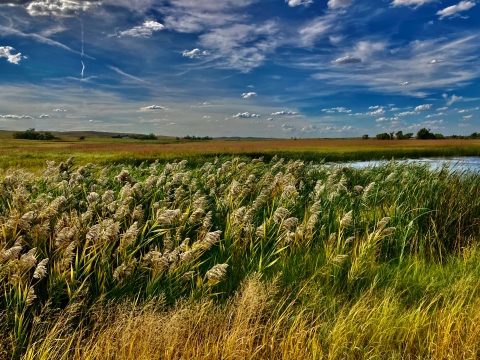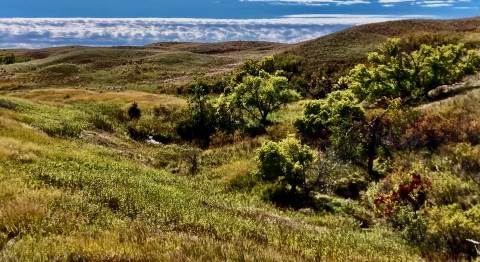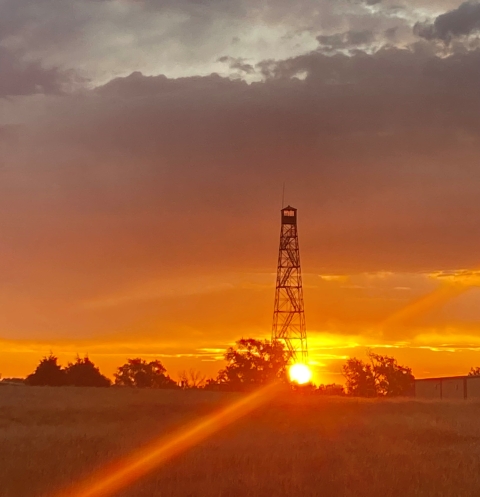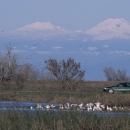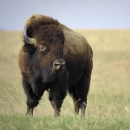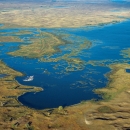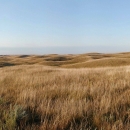About Us
Establishment
Lacreek National Wildlife Refuge was established in 1935 as a refuge and breeding ground for migratory birds and other wildlife. The Refuge contains a total of 16,570 acres and is located in Bennett County in southwestern South Dakota. It is the only refuge in South Dakota headquartered west of the Missouri River.
The Refuge lies in the shallow Lake Creek valley on the northern edge of the Nebraska Sandhills and includes native sandhills, sub-irrigated meadows, impounded fresh water marshes, and tall and mixed grass prairie uplands. The Refuge serves as an important staging area for migrating waterfowl, Sandhill cranes, shorebirds, and grassland dependent migratory birds. One important role is to provide critical wintering habitat for the high plains trumpeter swan population. Lacreek National Wildlife Refuge is in the Central Flyway, which is one of four major migratory bird flyways in North America.
It is known from historic records, that the Lacreek National Wildlife Refuge area was frequently visited and lived by various indigenous people during the 18th and 19th centuries; including the Lakota, Cheyenne, Arapahoe and Pawnee, to name a few. Although no prehistoric sites have been determined eligible for nomination to the National Register of Historic Places, future discoveries may change that situation.
Part of Lacreek National Wildlife Refuge's history is tied to the work done by the Civilian Conservation Corps and Works Progress Administration era of the mid-1930s. With the country experiencing severe unemployment, President Franklin D. Roosevelt, after only two days in office, created the Civilian Conservation Corps as a means to employ young men ages 18-25 to work in forests, parks, and rangelands. In addition, young men working under the Works Progress Administration built large structures including dams and levees to impound water and develop wetland habitat. These structures are still in use today!
Wetlands
Wetlands on the Refuge are managed to provide both resting cover and food for migratory birds during spring and fall migrations. Throughout the rest of the year, wetlands serve as production and maintenance habitat for waterfowl, other migratory birds, and resident wildlife. Substantial emergent and submergent vegetation occur in wetlands at the Refuge. Cattail, bulrushes, wild rice, smartweed and arrowhead abound, as well as sago pondweed, coontail and duckweed. Extensive mudflats created when wetlands are in the drawdown phase create quality food for migrating shorebirds and other neotropical species. Improved water quality and stimulated aquatic plant and insect growth occur during drawdowns and provide critical food, water, and shelter habitat for waterfowl, marsh/water birds, shorebirds, and neotropical migrants. Barnyard grass and annual smartweed that grow in the summer provide abundant seeds from the fall and spring migration and high aquatic insect populations when reflooded.
Wet Meadows
Wet meadows occur primarily in the valley on the western edge of Lacreek National Wildlife Refuge and along margins of the wetlands. They are categorized as wet meadows due to the presence of ground water near the surface. Even during drought, the groundwater provides plenty of water for lush plant growth. These wet meadows contain a variety of native forbs, grasses and sedges. The meadows are a glow in late summer with Maximillian and Nuttal's sunflowers, swamp milkweed, joe pye weed, and goldenrods. A wide variety of native grass grows here as well, including prairie cordgrass, Canada bluejoint, and big bluestem. An abundance of sedges can be found in the wettest sites, including Nebraska sedge, slough sedge, aquatic sedge, and bottlebrush sedge. Several species of willows and indigobush also grow here, adding fire tolerant shrubs to the landscape.
Wet meadows are managed to maintain the diverse native plant community that exists primarily through grazing and weed control. Grazing in the spring helps to stress non-native grasses such as Kentucky bluegrass and smooth brome grass that tend to establish and invade during long periods when no active management occurs. When the cattle are removed, the area regrows and most visitors will not even realize the site had been grazed that year. The grazing also helps with weed control by improving the effectiveness of application. Canada thistle and leafy spurge are the primary concerns.
These wet meadows provide important habitat for many grassland nesting birds, including northern harriers, short eared owls, bobolinks, dicksissels, sharp tailed grouse, and long billed curlews. The sunflower seeds that grow in abundance provide food for thousands of migrating and wintering American tree, Lincoln's, and white-throated sparrows. Hundreds of white-tailed and mule deer winter in the wet meadows along with concentrations of northern harriers and short eared owls.
Uplands and Nebraska Sandhills
There are approximately 4,900 acres of native grasses, of which 3,726 acres are in the Nebraska Sandhills. Big bluestem, little bluestem, sand bluestem, prairie sandreed, switchgrass, Indiangrass, Canada wildrye, June grass, sand dropseed, needle and thread grass, western wheatgrass, salt grass, among others and numerous native forbs (broad leafed plants) have all been noted on Refuge grassland transects. Cacti are also part of the landscape, including yucca and prickly pear. The Sandhills portion of the Refuge contain a diverse component of grass and forb species generally not found anywhere else on the Refuge.
The Refuge contains approximately 5,450 acres of exotic, introduced grass species. Smooth brome and crested wheatgrass are the primary exotic grasses followed by Kentucky bluegrass. During the 1930's, large fields formerly planted to crops were planted to crested wheatgrass to minimize soil erosion. Many of these large, crested wheatgrass fields remain on the Refuge. In the early 1970's, habitat management techniques were developed to provide dense nesting cover for waterfowl. Several areas on the Refuge were planted to grass species such as smooth bromegrass and alfalfa. These fields provided good cover for nesting birds; however, the species composition consisted of exotic cool season grasses. Over time, these fields were invaded by Canada thistle, a non-native species. The Refuge is currently working to restore these grasslands, along with the crested wheat grass fields, to native grasses and forbs. The native prairie restoration process generally involves cropping the field for several years to eliminate exotic cool season grasses, control Canada thistle and other noxious weeds, and prepare a seed bed for planting native grass seed.
Upland vegetation is maintained to provide nesting habitat for migratory birds (waterfowl and neotropical migrants) and resident bird species. Upland habitats also provide necessary habitat requirements for resident wildlife throughout the year. A variety of management techniques have been implemented to maintain and enhance upland habitat conditions on the Refuge including the use of prescribed fire, grazing, haying, native prairie restoration, and invasive species invasive species
An invasive species is any plant or animal that has spread or been introduced into a new area where they are, or could, cause harm to the environment, economy, or human, animal, or plant health. Their unwelcome presence can destroy ecosystems and cost millions of dollars.
Learn more about invasive species management.
Our Mission
Each unit of the National Wildlife Refuge System is established with a purpose that targets the conservation of native species dependent on its lands and waters. All activities on those acres are reviewed to ensure they are compatible with Refuge purposes.
Lacreek National Wildlife Refuge’s wetland resources create a sanctuary within the semi-arid Great Plains landscape. The Refuge provides a great diversity of uses for wildlife and humans alike. Refuge management guides hydrology to reflect natural conditions and restore native plant communities of the Lake Creek Valley and the adjacent sandhills for migratory birds and other native wildlife. Visitors learn about grasslands, wetlands, Sandhill ecosystems and enjoy wildlife-dependent recreation. Ongoing cooperation with partners and the public fosters appreciation and builds support for the Refuge’s biological communities and cultural history.
The purposes for the Refuge and wetland management district wetland management district
A wetland management district is a U.S. Fish and Wildlife Service office that manages waterfowl production areas in one or more counties. Waterfowl production areas are small natural wetlands and grasslands that provide breeding, resting and nesting habitat for waterfowl, shorebirds, grassland birds and other wildlife. The Fish and Wildlife Service acquires waterfowl production areas under the authority of the Migratory Bird Hunting and Conservation Stamp Act, primarily using funds from the sale of Federal Duck Stamps. The Refuge System’s 38 wetland management districts comprise thousands of waterfowl production areas – almost all in the Prairie Pothole Region of the Northern Great Plains.
Learn more about wetland management district are as follows:
- Executive Order, August 26, 1935 “…as a refuge and breeding ground for migratory birds and other wildlife…”
- Migratory Bird Conservation Act “…for use as an inviolate sanctuary, or for any other management purpose, for migratory birds.”
- The 223 acre Little White River Recreation Area was donated to and accepted by the Service on May 20, 1980 under the authority of the Refuge Recreation Act
- Refuge Recreation Act (16 USC 460K-K4) “…for public recreation on…developments adjacent to conservation areas in existence.”
- Migratory Bird Hunting Stamp Act 16 U.S.C. 718(c) “…as Waterfowl Production Areas subject to all provisions of the Migratory Bird Conservation Act …except the inviolate sanctuary provisions…”
- Migratory Bird Conservation Act 16 U.S.C. 715d “…for any other management purposes, for migratory birds.”
- Consolidated Farm and Rural Development Act 7 U.S.C. 1924 “… for conservation purposes.”
Our History
Refuge Establishment
Lacreek National Wildlife Refuge was established in 1935 by President Franklin D. Roosevelt through Executive Order No. 7160. The order establishes Lacreek National Wildlife Refuge “....as a refuge and breeding ground for migratory birds and other wildlife.” The Refuge lies in the Lake Creek Valley on the northern edge of the Nebraska Sandhills and includes 16,570 acres of native sandhills, sub-irrigated meadows, impounded fresh water marshes, and tall and mixed-grass prairie.
The Brown Ranch Addition, consisting of 6,662 acres was acquired under the authority of the Migratory Bird Conservation Act of 1929 on September 2, 1971 for use as an inviolate sanctuary, or for any other management purpose, for migratory birds. In 1981, the 223 acre Little White River Recreation Area was acquired under the authority of the Refuge Recreation Act (76 Stat. 653, as amended, 16 USC 460k). The 160 acre Charles Emley inholding was purchased in 1985 by authority of the Migratory Bird Conservation Act. Marty Vanderplough donated approximately 160 acres in 2017, bringing the total acreage of Lacreek Refuge to 16,570 acres.
Historic Resources
The Refuge’s early twentieth century history is closely tied to the Civilian Conservation Corps and Works Progress Administration. Young men enrolled in the Civilian Conservation Corps in the mid-to late 1930s completed much of the dike construction, completing work in the fall of 1939. The Works Progress Administration worked at the Refuge from 1937 to 1941. Young men working under the Works Progress Administration planted thousands of trees and shrubs on the Refuge. Both the Civilian Conservation Corps and Works Progress Administration were involved in building trails, dikes and landscaping.
Refuge buildings were constructed in 1936 and included a service garage and office, small cabin residence, equipment shed, lookout tower, and barn. The office, lookout tower and barn are presently standing on the Refuge and were determined to be eligible for the National Register of Historic Places (Register) in 1999, but to date, they have not been formally listed on the Register.
The Works Progress Administration constructed a picnic shelter in 1940-1941. The original fabric of the picnic shelter has been rebuilt over the years and it was determined to be ineligible for the Register in 2000.
Other Facilities in this Complex
Lacreek National Wildlife Refuge is included in the Sandhills National Wildlife Refuge Complex which includes Fort Niobrara, Valentine, Crescent Lake, North Platte and John W. and Louise Seier National Wildlife Refuges. Lacreek National Wildlife Refuge is the only station located in South Dakota, with the remaining stations located in Nebraska.
Fort Niobrara National Wildlife Refuge was once a frontier military fort, supports an exceptional diversity of plants and wildlife representative of the northern Great Plains and geographic regions east, west, north, and south of here. In the early 1900s, President Theodore Roosevelt and private conservation organizations, such as the National Audubon Society and American Bison Society, were becoming increasingly concerned with the exploitation of wildlife and their habitats on the Great Plains and elsewhere. As a result, an Executive Order was signed on January 11, 1912, establishing Fort Niobrara as a "preserve and breeding ground for native birds." Later that year, the Refuge's purpose was expanded to include the conservation of bison and elk herds representative of those that once roamed the Great Plains.
Valentine National Wildlife Refuge is 71,516 acres and is located in the Sandhills of north-central Nebraska. The Refuge is a unique and ecologically important component of the National Wildlife Refuge System (System) which includes more than 566 National Wildlife Refuges spanning approximately 100 million acres of lands and 750 million acres of oceans in the United States. The native grass prairie and wetlands found here support a diversity of wildlife. Little has changed from historic times. The Refuge was established by Congress in 1935 “as a breeding ground for migratory birds and other wildlife.” The Refuge is home to 270 species of birds, 59 species of mammals, and 22 species of reptiles and amphibians.
Crescent Lake National Wildlife Refuge lies on the southwestern edge of the Nebraska Sandhills, the largest sand dune in the Western Hemisphere. The Sandhills are characterized by rolling, vegetated hills and interdunal valleys. These habitats on the Refuge are interspersed with 21 wetland complexes—shallow lakes, marshes, seasonal wetlands, wet meadows, and a small stream. Wildlife diversity, except large ungulates and their predators, is relatively unchanged since early settlement.
North Platte National Wildlife Refuge was established in 1916 by Executive Order No. 2446 as a “preserve and breeding ground for native birds.” It is located in the Nebraska Panhandle, near Scottsbluff. It was declared a National Wildlife Refuge primarily because of fall concentrations of up to 250,000 Mallards, 11,000 Canada Geese and Bald Eagles.
John W. and Louise Seier National Wildlife Refuge is found in north-central Nebraska, as a sanctuary among the Sandhills. The Sandhills region is the largest remaining tract of mid and tall grass prairie in North America. The Seier Ranch was originally homesteaded by John and Louise Seier’s grandparents in the mid-1800's. John and Louise Seier did not have any immediate family, but did have a love of wildlife and an interest in preserving wildlife, they donated, their 2,400 acre working cattle ranch to U.S. Fish and Wildlife Service in October of 1999. Because the Refuge is so new to the System, it remains closed to the public at this time. There is no projected date for the opening of the Refuge, however, a date will be established upon the completion of a management plan.




